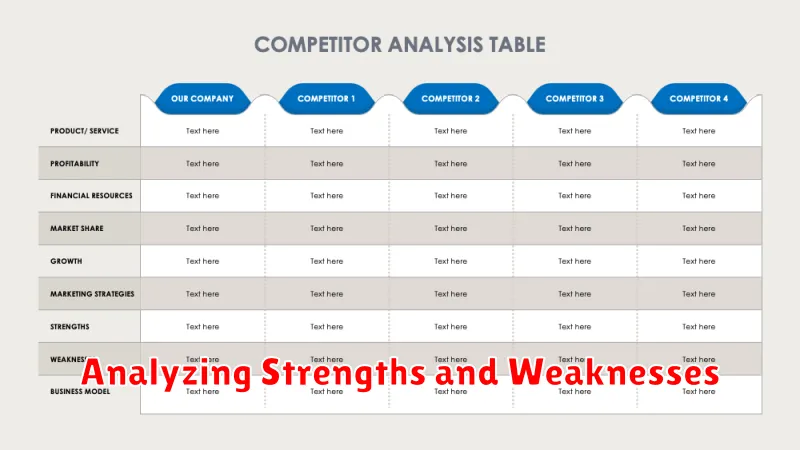In today’s dynamic market, understanding your competition is crucial for success. A competitive analysis provides invaluable insights into your rivals’ strategies, strengths, and weaknesses, enabling you to identify opportunities and threats. This knowledge empowers you to develop more effective marketing strategies, optimize your campaigns, and ultimately, gain a competitive advantage. This comprehensive guide will equip you with the knowledge and tools to conduct a thorough competitive analysis in marketing, covering key aspects such as identifying competitors, analyzing their marketing mix, and leveraging the information gathered to enhance your own marketing efforts.
Whether you are launching a new product, expanding into a new market, or simply seeking to refine your existing marketing strategy, a competitive analysis is an essential first step. By understanding the competitive landscape, you can make informed decisions about product development, pricing, distribution, and promotion. This article will provide a step-by-step approach to conducting a competitive analysis in marketing, helping you gain a deeper understanding of your competitors and develop winning strategies to outperform them in the marketplace. Learn how to identify your key competitors, analyze their marketing strategies, and leverage these insights to achieve sustainable competitive advantage.
Why Competitor Analysis Matters
Understanding your competition is crucial for success in any market. Competitor analysis provides valuable insights that inform strategic decision-making across all aspects of your marketing efforts.
By analyzing your competitors, you can identify opportunities and threats, allowing you to refine your strategies and optimize resource allocation. This knowledge enables you to develop stronger marketing campaigns, improve product development, and ultimately, achieve a competitive advantage.
Competitor analysis helps you understand their strengths and weaknesses, target audience, pricing strategies, and marketing tactics. This information empowers you to differentiate your offerings and position yourself effectively in the market.
Identifying Your Main Competitors
A crucial first step in competitive analysis is identifying your main competitors. This involves looking beyond the obvious. Consider both direct competitors, who offer similar products or services to the same target audience, and indirect competitors, who address the same customer need with a different solution.
Begin by brainstorming companies that readily come to mind. Then expand your search using online tools. Search for keywords related to your business and analyze search engine results. Explore industry directories and review sites. Social media platforms can also offer insights into who your audience engages with.
Categorizing competitors can be helpful. Consider creating a simple table or list to organize them by direct and indirect competition. This allows for a more focused analysis in later stages.
Analyzing Strengths and Weaknesses

This stage involves identifying your own company’s strengths and weaknesses as well as those of your competitors. A clear understanding of these factors is crucial for developing effective marketing strategies.
For your own business, consider internal factors such as pricing, distribution, product features, brand reputation, and customer service. For competitors, research their market share, marketing campaigns, target audience, and overall online presence.
A SWOT analysis (Strengths, Weaknesses, Opportunities, Threats) can be a valuable tool for organizing this information.
Using Insights to Your Advantage

After gathering and analyzing data on your competitors, the next crucial step is leveraging these insights to improve your own marketing strategies. This involves transforming raw data into actionable steps.
Identify Opportunities: Look for gaps in the market that your competitors haven’t addressed. Are there unmet customer needs you can fulfill? Can you offer a unique product or service feature?
Strengthen Weaknesses: The analysis may reveal areas where your competitors are outperforming you. Use this information to identify your own weaknesses and develop strategies to improve, such as enhancing customer service or optimizing pricing.
Refine Messaging: Understand how your competitors position themselves and tailor your messaging to highlight your unique selling propositions and differentiate your brand effectively.
Maintaining an Edge in the Market
Staying ahead of the competition requires continuous monitoring and adaptation. Regularly revisit your competitive analysis, ideally quarterly or biannually, to account for market shifts and competitor innovations. This ensures your strategies remain relevant and effective.
Implement a system for tracking competitor activities. This could involve subscribing to their newsletters, following their social media presence, or utilizing competitive intelligence tools. By staying informed about their marketing campaigns, product launches, and pricing strategies, you can proactively respond and maintain your competitive advantage.
Finally, foster a culture of innovation within your organization. Encourage experimentation and the development of new products and services. This proactive approach allows you to anticipate and meet evolving customer needs, keeping you one step ahead of the competition.

